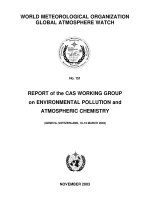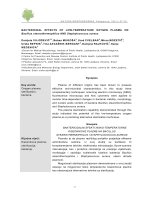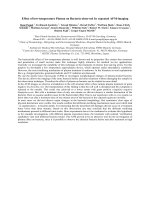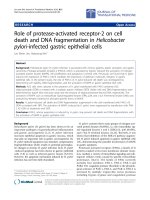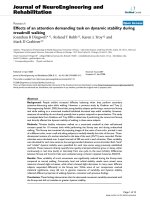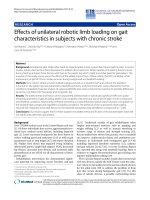Bactericidal effects of low temperature oxygen plasma on bacillus stearothermophilus and staphylococcus aureus
Bạn đang xem bản rút gọn của tài liệu. Xem và tải ngay bản đầy đủ của tài liệu tại đây (3.23 MB, 14 trang )
NATURA MONTENEGRINA, Podgorica, 10(1): 57-70
57
BACTERICIDAL EFFECTS OF LOW-TEMPERATURE OXYGEN PLASMA ON
Bacillus stearothermophilus AND Staphylococcus aureus
Danijela VUJOŠEVIĆ
1,3
, Boban MUGOŠA
2
, Uroš CVELBAR
3
, Miran MOZETIČ
3
,
Urška REPNIK
4
, Tina ZAVAŠNIK-BERGANT
4
, Danijela RAJKOVIĆ
1
, Sanja
MEDENICA
2
1Centre for Medical Microbiology, Institute of Public Health, Ljubljanska bb, 81000 Podgorica,
Montenegro. Email:
2 Centre for Prevention and Disease Control, Institute of Public Health, Ljubljanska bb, 81000
Podgorica, Montenegro. Email:
3 Plasma Laboratory F4, Jožef Stefan Institute, Jamova 39, 1000 Ljubljana, Slovenia. Email:
4 Biochemistry and Molecular Biology Department, Jožef Stefan Institute, Jamova 39, 1000 Ljubljana,
Slovenia. Email:
Key words:
Oxygen plasma,
sterilization,
bacteria.
Synopsis
Plasma of different origins has been shown to possess
effective anti-microbial characteristics. In this study three
complementary techniques: scanning electron microscopy (SEM),
fluorescence microscopy and flow cytometry were applied to
monitor time-dependent changes in bacterial viability, morphology
and nucleic acids content of bacteria Bacillus stearothermophilus
and Staphylococcus aureus.
The plasma sterilization capability demonstrated through this
study indicated the potential of this low-temperature oxygen
plasma as a promising alternative sterilization technique.
Ključne riječi:
Kiseonikova plazma,
sterilizacija,
bakterije.
Sinopsis
BAKTERICIDALNI EFEKTI NISKO-TEMPERATURNE
KISEONIKOVE PLAZME NA BACILLUS
STEAROTHERMOPHILUS I STAPHYLOCOCCUS AUREUS
Poznato je da plazma različitog porijekla posjeduje efikasne
antimikrobne osobine. U ovoj studiji su korištene tri
komplementarne tehnike: elektronska mikroskopija, fluore-scentna
mikroskopija, kao i protočna citometrija za praćenje vijabilnosti,
morfologije i sadržaja nukleinskih kiselina bakterija Bacillus
stearothermophilus i Staphylococcus aureus, nakon obrade
plazmom.
Mogućnosti sterilizacije plazmom demonstrirane u ovoj studiji
ukazuju na mogućnost nisko temperaturne kiseonikove plazme
kao obećavajuće alternativne tehnike za sterilizaciju.
Vulošević et al:
BACTERICIDAL EFFECTS OF LOW-TEMPERATURE OXYGEN PLASMA ON . . .
58
INTRODUCTION
A novel sterilization method capable of more rapidly killing microorganisms
and less damaging material is low-temperature plasma sterilization (CHAU et al.,
1996). The plasma sterilization is safer as opposed to classical sterilization of heat
sensitive material with ethylene oxide which leaves highly toxic residues absorbed in
the sterilized material, whereas no residuals are left on the surface after plasma
treatment (PHILIP et al., 2000). Low-temperature plasma is effective against a broad
range of bacteria and killing these microorganisms by producing various reactive
species like oxygen, hydroxyl free radicals, and other active species, although these
killing mechanisms are still being studied (GADRI et al., 2000; LAROUSSI et al.,
2004).
Therefore, a relatively simple and inexpensive design and the absence of the
toxicity resulting from the treatment itself, give low-temperature plasma the potential
to replace conventional sterilization methods of medical devices, such as implants,
dental instruments etc (MOISAN et al., 2002; JACOBS & LIN, 2001; SAMUEL, et al.,
1998; HELHEL et al., 2005).
However, the research of low-temperature plasma sterilization has the complex
issue, which is further burdened by a large number of experiment variables, is
insufficiently definitive about the selected methodologies and experimental
conditions. Certainly, more tests and in-depth study of low-temperature sterilization
are needed to elucidate the mechanism of low-temperature plasma sterilization
(CHOI et al., 2006).
There is a need for reliable and accurate monitoring of plasma sterilization
during the process and evaluating after. In the plasma, a large number of variables
influence the whole system between physical and chemical process. However, till
now no reliable methods have been found to access the sterilization during sample
processing in plasma. Monitoring during the process can be done by measuring
changes of reactive species in plasma. Reliable and accurate plasma diagnostic
techniques are presently being developed to provide real-time information on plasma
during system operation (KANAZAWA, et al., 1989). And more, new, faster and more
accurate techniques for evaluation of post treated bacteria need to be developed,
apart from standard count plate technique.
The purpose of this study was to determine the sterilization effects of low-
temperature highly dissociated oxygen plasma on two selected Gram positive
bacteria, i.e. on temperature resisting
Bacillus stearothermophilus and on
Staphylococcus aureus, commonly involved in infections and food poisoning. Three
complementary techniques apart from plate counting; scanning electron microscopy
(SEM), fluorescence microscopy and flow cytometry were applied to monitor time-
dependent changes in bacterial viability, morphology and nucleic acids content, all in
comparison to heat-treated bacteria at 140 °C.
Natura Montenegrina 10(1)
59
MATERIAL AND METHODS
Bacteria. Bacillus stearothermophilus (ATCC No. 7953) and Staphylococcus
aureus (ATCC No. 25923) were obtained from the MicroBioLogics CE (MN, USA).
Bacterial cultures were grown overnight on Colombia agar plates (Difco
Laboratories, MI, USA) at 55
o
C for Bacillus stearothermophilus and 37
o
C for
Staphylococcus aureus. Cells were harvested and resuspended in sterile water. 100
µl suspension containing 1 × 10
7
cells of Bacillus stearothermophilus and
Staphylococcus aureus were evenly distributed on the surface of sterile glass or
aluminum substrate and air dried in a laminar-flow hood. Bacteria on carriers were
then either exposed to low-temperature oxygen plasma, or vacuum-treated, or high-
temperature dry heated or remained un-treated (control).
Carriers. Pyrex glass rectangular substrate and aluminum sheets were used
as carriers for bacteria. Glass carriers were used when, later on, fluorescence or
flow cytometry were applied, while aluminum sheets were used with SEM, in order to
avoid charging effects inside the electron microscope.
Carriers’ activation. Both carriers were well activated prior to bacteria
deposition to avoid bacteria agglomeration and in order to achieve uniform even
distribution of cells across the entire carrier and the formation of thin layer of cells
on the carrier’s surface. The activation process was also performed by oxygen
plasma treatment for 5 s. Plasma with the same characteristic parameters was used
for both, the activation of carriers and for the treatment of bacteria.
Heat treatment. For studying of temperature effects on bacteria degradation
the samples (bacteria on substrate carriers) were treated with high temperature dry
heat at 140 ° C for 20 s, 2 min and 10 min.
Plasma treatment. Inductively coupled radio-frequency generator with the
output power of about 200 W and the frequency of 27.12 MHz was used to create
uniform plasma in a glass tube with the inner diameter of 36 mm and the length of
65 cm (Figure 1). The tube was first evacuated to the pressure of 3 Pa and then
filled with oxygen to pressure from 30 Pa to 150 Pa. Plasma parameters (electron
temperature, neutral O-atom density, ion density) were measured with a double
Langmuir probe and Fiber Optics Catalytic Probes.
Samples were exposed for different treatment time to plasma with the electron
temperature of 5 eV, the neutral O-atom density of approximately 8.5 × 10
21
m
-3
and
the ion density of 1.4 × 10
16
m
-3
. In another control experiment, bacteria were exposed
to vacuum conditions but without plasma in order to detect possible changes caused
by evacuation only and not by plasma.
Vulošević et al:
BACTERICIDAL EFFECTS OF LOW-TEMPERATURE OXYGEN PLASMA ON . . .
60
Figure 1. Schematic of the discharge vessel.
Plate counts technique. Before and after each treatment the samples (bacteria
on carriers) were placed in sterile containers with 2 ml 0.85% NaCl saline solution.
The containers were then briefly vortexed in order to wash bacterial cells from
carriers. The suspension was serially diluted (1/10) in saline to the required
concentration range. A sample of 100 µl of the diluted suspension was inoculated onto
Colombia agar plate. Plates were than incubated at 37 °C (Staphylococcus aureus)
and 55
o
C (Bacillus stearothermophilus), respectively for 24-48 h. Colony forming
units were finally counted to determine the number of survivors of bacteria.
Scanning electron microscopy (SEM). Samples were imaged using field-
emission scanning electron microscopy at a low kinetic energy of primary electrons.
Low-temperature oxygen plasma-treated bacteria, high temperature dry heat-treated
bacteria, vacuum-treated bacteria (control) and un-treated bacteria (control) on
aluminum carriers were viewed in the Carl Zeiss Supra 35 VP scanning electron
microscope. Images were taken at approx. 10
-3
Pa with a beam of primary electrons at
1000 eV and 600 eV.
Fluorescence microscopy. Fluorescently labeled low-temperature oxygen
plasma-treated bacteria, high-temperature dry heat-treated bacteria, vacuum-treated
bacteria and un-treated bacteria on glass carriers were viewed using wide-field
fluorescence microscopy. LIVE/DEAD BacLight
TM
bacterial viability kit L7012
(Molecular Probes, The Netherlands) was used to stain bacteria on glass carriers
according to the manufacturer’s procedure. For staining solution two DNA stains
SYTO 9 (3.34 mM) and propidium iodide (PI, 20 mM), were mixed together (1.5 µl +
1.5 µl) and diluted with 1 ml of deionised sterile water. Bacteria were incubated with
20 µl of staining solution at room temperature in the dark. After 15 min, cells were
washed with deionised sterile water and viewed under the inverted fluorescence
microscope Olympus IX71 with digital camera Olympus DP50. Green fluorescence
signal of SYTO 9 and red fluorescence signal of PI were detected using U-M41001
(exc. 461 - 500 nm / em. 511 - 560 nm) and U-MWIY2 (exc. 545 – 580 nm / em. > 600
nm) Olympus filter cubes, respectively. Oil objectives × 60 (N.A. = 1.40) and ×100
(N.A. = 1.35) were used.
Natura Montenegrina 10(1)
61
Flow cytometry. Fluorescently labeled low-temperature oxygen plasma-treated
bacteria, dry heat-treated bacteria and un-treated bacteria on glass carriers were
analyzed on a FACSCalibur flow cytometer using CellQuest software, version 3.3
(Becton Dickinson, CA). After treatment, glass carriers were gently washed with sterile
0,85% NaCl in order to prepare a single-cell solution. LIVE/DEAD BacLight
TM
bacterial
viability kit L7012 (Molecular Probes, The Netherlands) was used to stain bacteria. In
500 µl of a cell suspension, 0.75 µl of 3.34 mM SYTO 9 and 0.75 µl on 30 mM PI were
added, and the suspension was then incubated at room temperature for 15 min,
protected from the light. The analysis gate was set in the untreated sample in dot
plots of green (FL1, SYTO 9) and red (FL3, PI) fluorescence versus side scatter.
RESULTS WITH DISCUSSION
Plasma characteristics and activation of carriers. Prior to experiments
performed on bacteria characteristic parameters in low-temperature oxygen plasma
were measured with a double Langmuir probe and a Fibre Optics Catalytic Probes.
The determined electron temperature was 5 eV, the neutral O-atom density was 8.5 ×
10
21
m
-3
and the ion density was 1.4 × 10
16
m
-3
. As observed, in generated oxygen
plasma the degree of dissociation of oxygen (O
2
(g)) to neutral O atoms (O• (g))
exceeded the ionization fraction by more than 5 orders of magnitude, i.e. allowing for
almost entire plasma to interact as oxygen radicals with bacteria. These plasma
parameters were kept constant during all experiments with cells described in
continuation.
The activation of carriers was done in the period of 5 s. Taking into account that
in plasma the flux of O atoms was about 1 × 10
23
m
-2
s
-1
, the dose of atoms which was
received by carriers exceeded 1 × 10
24
m
-2
, i.e. 1 × 10
12
m
-2
. This flux of O atoms
allowed high surface energy by mostly removing impurities of a particular Al and glass
carrier, respectively. In this way, even distribution of bacteria cells on the entire
carrier surface was enabled. Furthermore, X-ray photoelectron spectroscopy (XPS)
analysis of thus activated Al and glass carriers showed no traces of organic
impurities, which could cause a decrease of surface energy and consequently uneven
distribution of bacteria later on. Therefore, we have concluded that bacteria were
deposited on well activated carriers.
Samples were exposed to plasma separately for different periods of time. The
density of free O atoms in plasma was the same (i.e. approximately 8.5 × 10
21
m
-3
), as
it was used previously for the activation of carriers. The flux of O atoms was 1 × 10
23
m
-2
s
-1
and the dose of free O atoms which were received by bacteria again exceeded
1 × 10
24
m
-2
.
Vulošević et al:
BACTERICIDAL EFFECTS OF LOW-TEMPERATURE OXYGEN PLASMA ON . . .
62
Morphological changes caused by low-temperature oxygen plasma. To
better investigate the effects on the cell structure changes during the oxygen plasma
sterilization process, scanning electron microscopy (SEM) was used to obtain the cell
image on both: un-treated and treated bacteria. Representative SEM micrographs of
the un-treated bacteria (Figure 2), bacteria treated with dry heat at 140 °C (Figure 3
and 4) and bacteria treated with low-temperature highly dissociated oxygen plasma
(Figure 5) have been taken. The un-treated bacteria Bacillus stearothermophilus
(Figure 2a) and Staphylococcus aureus (Figure 2b) exhibit regular rod-shaped and
coccoid form, respectively. Furthermore, no alterations or lesions of the cell wall were
observed for the un-treated bacteria.
Figure 2. SEM micrographs of un-treated bacteria on aluminium substrate: (a) Bacillus
stearothermophilus and (b) Staphylococcus aureus.
Figure 3. SEM photographs of heat-treated bacteria at 140 °C for 20 seconds: (a)
Bacillus stearothermophilus and (b) Staphylococcus aureus.
SEM images of the bacteria treated with dry heat at 140 °C either 20 s (Figs.
3a and 3b) or 10 min (Figure 4a and b) show that Bacillus stearothermophilus still
retained its typical rod shaped form (Figure 3a and 4a) and Staphylococcus aureus
Natura Montenegrina 10(1)
63
still its typical coccoid form (Figure 3b and 4b). Both thus appeared quite similar to
the un-treated cells in the control experiments (Figure 2a and b).
Nevertheless, some changes in bacterial cell wall morphology were observed
after prolonged treatment time at 140 °C indicating certain effect of high temperature
on bacterial cells after 10 min (Figure 4a and b). On the other hand, after 20 s at
140 °C no visible changes in cell wall morphology were observed (Figure 3a and b).
Figure 4. SEM photographs of heat-treated bacteria at 140 °C for 10 minutes: (a) Bacillus
stearothermophilus and (b) Staphylococcus aureus.
Figure 5. SEM photographs of bacteria treated with low-temperature highly dissociated
oxygen plasma for 20 seconds: (a) Bacillus stearothermophilus and (b) Staphylococcus
aureus.
In contrast, treatment with highly dissociated oxygen plasma for 20 s resulted
in a significant reduction of cell size and in modified morphology (Figure 5)
compared to the un-treated controls (Figure 2) or thermally treated bacteria (Figure
3 and 4). Bacteria Bacillus stearothermophilus (Figure 5a) and Staphylococcus
aureus (Figure 5 b) became badly damaged; their cell membrane and cytoplasm
were strongly eroded and ruptured. Cells in plasma completely lost their cell integrity
Vulošević et al:
BACTERICIDAL EFFECTS OF LOW-TEMPERATURE OXYGEN PLASMA ON . . .
64
already after 20 s with cell wall and bacterial cytoplasm becoming barely
recognizable (Figure 5).
Even longer than 20 s (up to 240 s) were also tested and, expectedly, bacteria
Bacillus stearothermophilus (Figure 6) and Staphylococcus aureus (Figure 7) were
completely destroyed after the prolonged plasma treatment.
Figure 6. SEM photographs of bacteria Bacillus stearothermophilus treated with low-
temperature highly dissociated oxygen plasma: (a) for 55 seconds; (b) for 240 seconds.
Figure 7. SEM photographs of bacteria Staphylococcus aureus treated with low-
temperature highly dissociated oxygen plasma: (a) for 60 seconds; (b) for 240 seconds.
Another control experiment was performed with Bacillus stearothermophilus
and Staphylococcus aureus in such a way that bacteria were exposed to the vacuum
only but without plasma. The size and shape of bacteria did not depend on this pre-
treatment under vacuum conditions (Figure 8). Furthermore, SEM did not confirm
any notable changes on the surface of bacteria which would be caused directly by
vacuum, used in a reactor during plasma experiment.
We have thus concluded that, in our experiments, evacuation itself did not
cause any visible morphological changes of bacteria.
These result demonstrated that a strong etching process of the plasma caused
the sterilizing effect on the bacteria, when they were exposed to this low-
temperature highly dissociated oxygen plasma. Bacteria have been heavily
damaged, reduced to microscopic debris, ruptured with their cellular contents
Natura Montenegrina 10(1)
65
released on the substrate surface. In addition, for longer exposure times, total cell
fragmentation was observed. This demonstrates that the plasma has direct physical
impact on the cells.
Figure 8. SEM photographs of vacuum-treated bacteria: (a) Bacillus stearothermophilus
and (b) Staphylococcus aureus.
Fluorescence labeling. Viability of bacteria was assessed with the
DEAD/LIVE BacLight
TM
Viability Kit. It consists of two dyes, SYTO 9 can enter
bacteria with intact cell membranes and emits green fluorescence, whereas
propidium iodide (PI) penetrates only into bacterial cells with damaged membranes
and exhibits red fluorescence. When bacterial cells are stained with a mixture of the
two dyes, viable cells fluorescence bright green, while dead cells exhibit weaker
green fluorescence and also fluoresce red. This differential staining was particularly
obvious when cells were observed under the fluorescent microscope. In Figure 9
(Bacillus stearothermophilus) and Figure 10 (Staphylococcus aureus) binding of
DNA dye SYTO 9 and PI is shown for the un-treated bacteria (a, d), the bacteria
treated with high-temperature dry heat at 140 °C for 10 min (b, e) and the bacteria
treated with low-temperature highly dissociated oxygen plasma for 20 s (c, f).
Binding of DNA dyes to bacteria treated with high-temperature dry heat for 20 s at
140 °C is not shown, because no morphological changes of bacterial cell wall were
observed with SEM after 20 s
In our experiments, the un-treated bacteria Bacillus stearothermophilus
showed strong SYTO 9 staining (green fluorescence, Figure 9a) but very weak PI
staining (red fluorescence, Figure 9d). In high-temperature-treated bacteria, the
number of PI-stained cells stained increased compared to SYTO 9 only-stained cells
(Figure 9b and e). Plasma-treated bacteria show neither SYTO 9 (Figure 9c) nor PI
(Figure 9f) fluorescence signal. SYTO 9 and propidium iodide bind to the nucleic
acids, then absence of fluorescence could be explained by denaturation and/or
fragmentation bacterial DNA.
Vulošević et al:
BACTERICIDAL EFFECTS OF LOW-TEMPERATURE OXYGEN PLASMA ON . . .
66
Figure 9. Fluorescence microscopy images of bacteria Bacillus stearothermophilus
labelled with DNA dyes: SYTO 9 (green fluorescence in a, b and c) and propidium iodide
(red fluorescence in d, e and f).
(a, d) un-treated bacteria, (b, e) bacteria treated with high-temperature dry heat for 10
minutes at 140 ° C and (c, f) bacteria treated with low-temperature highly dissociated
oxygen plasma for 20 seconds. Un-treated bacteria show strong SYTO 9 (a) staining
(fluorescence) but weak propidium iodine (PI) staining (d). In high-temperature treated
bacteria PI staining (red fluorescence) increased (e) compared to SYTO 9 (b). Plasma
treated-bacteria show no SYTO 9 (c) or PI (f) fluorescence signal.
Binding of DNA SYTO 9 and PI in bacteria Staphylococcus aureus exhibited
quite a similar way of staining (Figure 10). The un-treated bacteria showed strong
SYTO 9 staining (Figure 10a, green fluorescence). In contrast to the un-treated
bacteria Bacillus stearothermophilus, there were some PI-stained bacteria
Staphylococcus aureus cells already in the un-treated sample (Figure 10d). In high-
temperature-treated bacteria, PI-stained bacteria dominated (Figure 10e, red
fluorescence) and only a few cells remained SYTO 9 positive (Figure 10b, green
fluorescence) and PI negative (Figure 10e). Plasma treated-bacteria Staphylococcus
aureus showed neither SYTO 9 (Figure 10c) nor PI (Figure 10f) fluorescence, the
same as Bacillus stearothermophilus.
In the case of plasma-treated bacteria, the original DNA is either heavily
modified or fully oxidized, so there is practically no DNA left to assure stain binding.
Degradation of bacterial DNA is achieved by oxygen radicals, especially neutral
oxygen atoms. The resulted emitted fluorescence is poor: stain is evenly distributed
on the carrier showing no preference to the sites where bacteria reside. This
Natura Montenegrina 10(1)
67
confirms also the nature of low temperature plasma sterilization, where neutral
atoms interact chemically with bacteria material. The atoms homogeneously erode
bacteria envelope and destroy its DNA, by etching.
Figure 10. Fluorescence microscopy images of bacteria Staphylococcus aureus labelled
with DNA dyes SYTO 9 (green fluorescence in a, b and c) propidium iodide (red
fluorescence in d, e and f).
(a, d) un-treated bacteria, (b, e) bacteria treated with high-temperature dry heat for 10
minutes at 140 °
C and (c, f) bacteria treated with low-temperature highly dissociated
oxygen plasma for 20 seconds. Un-treated bacteria show strong SYTO 9 (a) staining
(green fluorescence). In un-treated bacteria, certain percentage of SYTO 9-negative cells
also shows propidium iodine (PI) staining (d). For high-temperature treated bacteria PI
staining (red fluorescence) increased (e) compared to SYTO 9 (b). Plasma treated-
bacteria show no SYTO 9 (c) or PI (f) fluorescence signal.
Flow cytometric analysis. In addition to the microscopy, bacteria stained with
SYTO 9 and PI were also analyzed by flow cytometry. Bacteria were either un-
treated, treated with dry heat at 140 °C for 20 s, 2 min or 10 min, or with low-
temperature highly dissociated oxygen plasma for 20 s or 2 min. After the treatment,
bacteria were gently washed from the carriers in order to obtain a suitable
suspension. In Figure 11 and 12, results for Bacillus stearothermophilus and
Staphylococcus aureus, respectively, are displayed.
Vulošević et al:
BACTERICIDAL EFFECTS OF LOW-TEMPERATURE OXYGEN PLASMA ON . . .
68
Figure 11. Flow cytometric analysis of Bacillus stearothermophilus using LIVE/DEAD
BacLight
TM
Bacterial Viability Kit. Suspension of (a) un-treated; (b) treated with dry heat
at 140 °C for 20 s; (c) treated with dry heat at 140 °C for 2 min; (d) treated with dry heat
at 140 °C for 10 min, or (e) with low-temperature highly dissociated oxygen plasma for
20 s and (f) with low-temperature highly dissociated oxygen plasma for 2 min, were
stained and analyzed according to the kit protocol.
Figure 12. Flow cytometric analysis of Staphylococcus aureus using LIVE/DEAD
BacLight
TM
Bacterial Viability Kit. Suspension of (a) un-treated; (b) treated with dry heat
at 140 °C for 20 s; (c) treated with dry heat at 140 °C for 2 min; (d) treated with dry heat
at 140 °C for 10 min, or (e) with low-temperature highly dissociated oxygen plasma for
20 s and (f) with low-temperature highly dissociated oxygen plasma for 2 min, were
stained and analyzed according to the kit protocol.
The analysis gate was set in the untreated cells using green and red
fluorescence versus side scatter. Live and dead bacteria appeared as two
populations of different green intensity fluorescence. In Bacilus stearothermophilus,
the untreated sample has 80% of viable cells. The viability was halved after 20 s
exposure to 140°C, while after 2min exposure at 140°C almost all cells had already
died. After 10 min exposure to 140°C, the number of cells in the analysis gate was
Natura Montenegrina 10(1)
69
reduced. In plasma treated samples, the percentage of live bacteria decreased
faster than in heat-treated samples. Furthermore, the number of cells in the analysis
gate has been significantly reduced already after 20 s and there had hardly been
any cells left after 2 min plasma treatment. In Staphylococcus. aureus, the results
were very similar. However, the difference in the effectiveness of heat and plasma
treatments was even more pronounced. The viability of the untreated sample was
above 95%. 20 s exposure to 140°C did not significantly affect the viability, whereas
after 2 min, the viability was almost halved, and after 10 min exposure, almost all of
the cells left were dead. In contrast, already 20 s of plasma treatment was enough to
kill almost all bacteria and after 2 min plasma treatment, only a few cells were left in
the analysis gate.
The results of this analysis suggest that low-temperature plasma sterilization is
not only capable of killing bacteria, but it also capable of removing the dead bacteria
cells from the surface of the objects being sterilized. This method proved to be very
efficient monitoring method as well as quantifying method for detection of dead and
live bacteria after the plasma treatment.
CONCLUSION
For sterilization effects of low-temperature highly dissociated oxygen plasma,
we came to following conclusions:
The results of the SEM analyses demonstrated that a strong etching process of
the plasma caused the sterilizing effect on the bacteria, when they were exposed to
this low-temperature highly dissociated oxygen plasma.
The results of bacterial destruction obtained by epifluorescence observations
clearly showed that in the case of plasma-treated bacteria the original DNA is either
heavily modified or fully oxidized, so there is practically no DNA left to assure stain
binding.
The results of flow cytometric analysis suggest that low-temperature plasma
sterilization is not only capable of killing bacteria, but it is also capable of removing
the dead bacteria cells from the surface of the objects being sterilized. Reduction in
cell viability was achieved on various types of bacteria.
The plasma sterilization capability demonstrated through this study indicated
the potential of this low-temperature highly dissociated oxygen plasma as a
promising alternative sterilization technique.
ACKNOWLEDGEMENT
The research was supported by Slovenian Ministry of Science and Montenegro Government,
Grant No. 1.BI-SLO-CG 07-08.
Vulošević et al:
BACTERICIDAL EFFECTS OF LOW-TEMPERATURE OXYGEN PLASMA ON . . .
70
REFERENCES:
CHAU, T. T., KWAN, C. K., GREGORY, B., FRANCISCO, M. 1996: Microwave Plasmas for
Low Temperature Dry Sterilization. – Biomaterials, 17: 1273-1277.
PHILIP, N., SAOUDI, B., CREVIER, M. C., MOISAN, M., BARBEAU, J., PELLETIER, J. 2002:
The Respective Roles of UV Photons and Oxygen Atoms in Plasma Sterilization at
Reduced Gas Pressure: The case of N2-O2 mixtures. - IEEE Transactions on Plasma
Science, 30: 1429-14435.
GADRI, R. B., ROTH, J. R., KELLY-WINTENBERG, K., FELDMAN, P., CHEN, Z. 2000:
Sterilization and Plasma Processing of Room Temperature Surfaces with a One
Atmosphere Uniform Glow Discharge Plasma (OAUGDP). – Surface & Coatings
Technology, 131: 528–542.
LAROUSSI, M., LEIPOLD F. 2004: Evaluation of the Roles of Reactive Species, Heat, and
UV Radiation in the Inactivation of Bacterial Cells by Air Plasmas at Atmospheric
Pressure. - International Journal of Mass Spectrometry, 233: 81-86.
MOISAN, M., BARBEAU, J., CREVIER, M. C. 2002: Plasma Sterilization. Methods and
Mechanisms. - Pure and Applied Chemistry, 74: 349-358.
JACOBS, P. T., & LIN S. M. 2001: Sterilization Process Utilizing Low-temperature Plasma.
In: Block, S. S. (Eds), Disinfection, Sterilization, and Preservation. – Philadelphia,
Lippincott, Williams & Wilkins. pp: 747-763.
SAMUEL, A. H., MATTHEWS, I. P. 1998: Microwave Description: a Combined
Sterilizer/Aerator for the Accelerated Elimination of Ethylene Oxide Residues from
Sterilized Supplies. - Medical Instrumentation, 22: 39-44.
HELHEL S., OKSUZ, L. & YOUSEFI A. R. 2005: Silicone Catheter Sterilization by Microwave
Plasma; Argon and Nitrogen Discharge. - International Journal of Infrared and
Millimeter Waves, 26: 1613-1625.
CHOI J. H., HAN I., BAIK, H. K. 2006: Analysis of Sterilization Effect by Pulsed Dielectric
Barrier Discharge. - Journal of Electrostatic, 64: 17-22.
KANAZAWA, S., KOGOMA, M., MORIWAKI, S. 1989: Glow Plasma Treatment at Atmospheric
Pressure for Surface Modification and Film Depositon. - Nuclear Instruments &
Methods in Physics, 37-38: 842-845.
Received: 16 June 2010


